Serial houseplant killers pay attention! If you’ve always had trouble keeping houseplants alive the traditional way, why not try something different?
Growing houseplants in water rather than soil is a great option for a surprising amount of different popular species. A perfect solution for the travelers and busy folks among us!
Let’s have a look at everything you need to know about growing cuttings in water, how to do it, and a list of popular plants that grow in water just as well as they do in soil.
Disclosure: If you shop from my article or make a purchase through one of my links, I may receive commissions on some of the products I recommend.
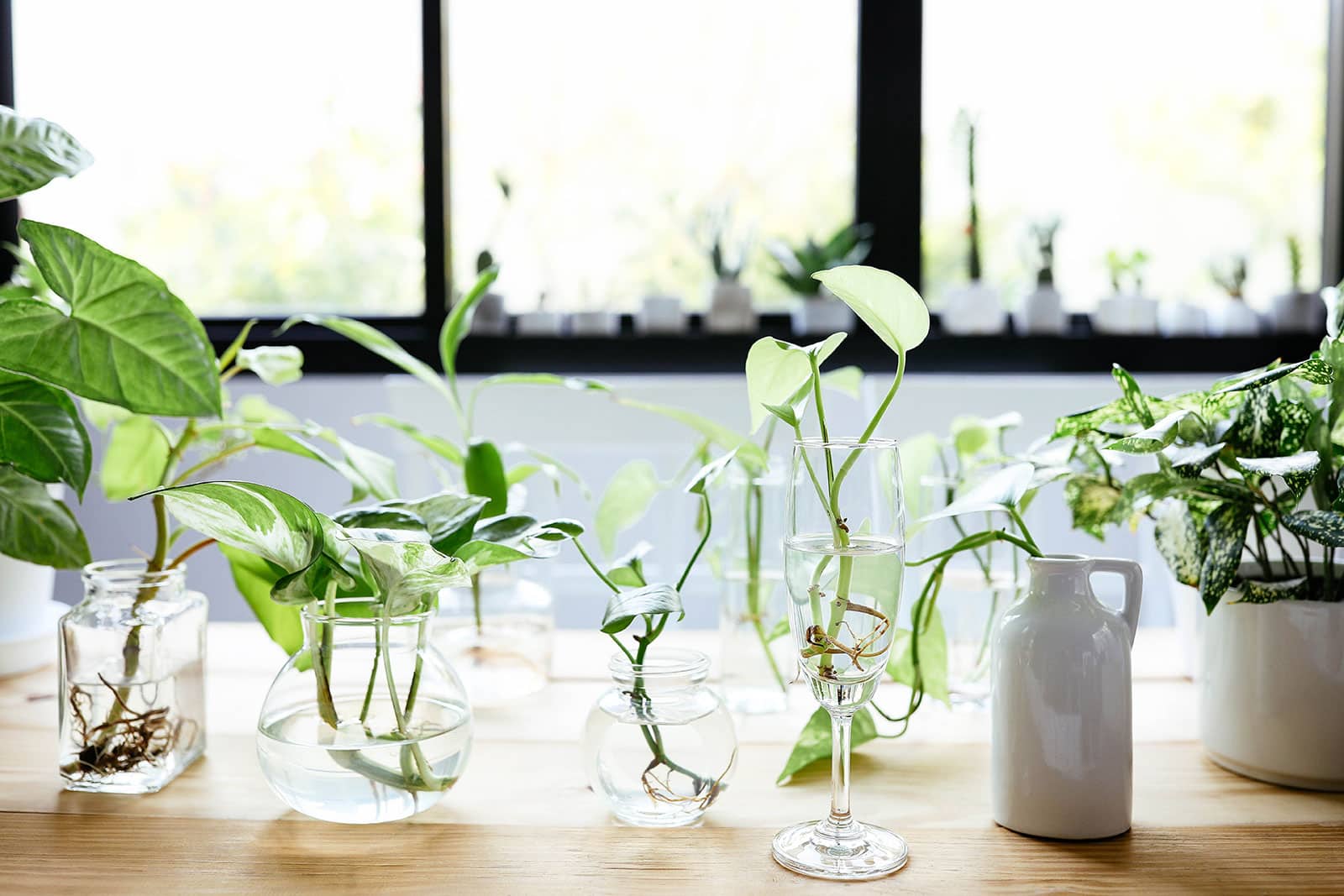
Can you (or should you) grow plants in water?
Ah, houseplants. We all love them and what they do for the look of our homes, but keeping them alive is often a different story. Too little water kills them, but so does too much water. The same goes for fertilizer, and let’s not even talk about those species that seem to shrivel if you just look at them wrong!
It’s easy to think you’ve got a bad thumb if you’ve failed to keep a few houseplants alive, but I encourage aspiring houseplant growers to look at things differently. Rather than just giving up and going for faux plants, it’s all about being creative in finding a way to keep houseplants alive and thriving, one that works for you and your schedule.
One way to do this is to try growing your plants in water, with their roots submerged but their stems and foliage sticking out. It’s not something that works for every plant lover, nor for every plant, but it can be such a lifesaver that I sometimes wonder why more people don’t do it!
Many of us long-time enthusiasts already root cuttings in water, but few realize you can also just grow plants this way indefinitely.
Just imagine:
- You almost never have to water your plant(s). This eliminates the risk of overwatering or the leaves wilting from thirst.
- Travel without worrying about your plants and without having to arrange a plant sitter.
- You get to be creative with beautiful displays in funky vases.
- You get to see your plant’s roots grow, allowing you to keep an eye on root health as an added bonus.
Related: How to water your houseplants in the bathtub
In horticulture, growing plants in water is called hydroponics. If your interest has been piqued, let’s have a look at how to do it. I promise it’s easy!
Did you know?
There’s also a growing method called “semi-hydroponics,” which involves placing houseplants in a soil-less medium called LECA, plus water. We won’t discuss it here, but it’s a good option to explore later if you’re enjoying growing your houseplants in water.
How to grow houseplants hydroponically
If you’d like to grow a houseplant in water, you can start with a fully grown plant previously grown in soil or with a cutting. I’ve tried both methods and they’ve worked fine, although I personally prefer using cuttings. It saves me the time of having to clean all the dirt off the roots first, and also eliminate the small chance of a plant failing to adapt to life in water.
We’ll discuss a bunch of different plants that grow in water in a bit. You can take pretty much any of these (the vining ones are especially vigorous growers), snip off a piece and pop it in a pretty vase. Just make sure the stem is submerged, but the leaves are not. It’ll develop a thriving root system before you know it.
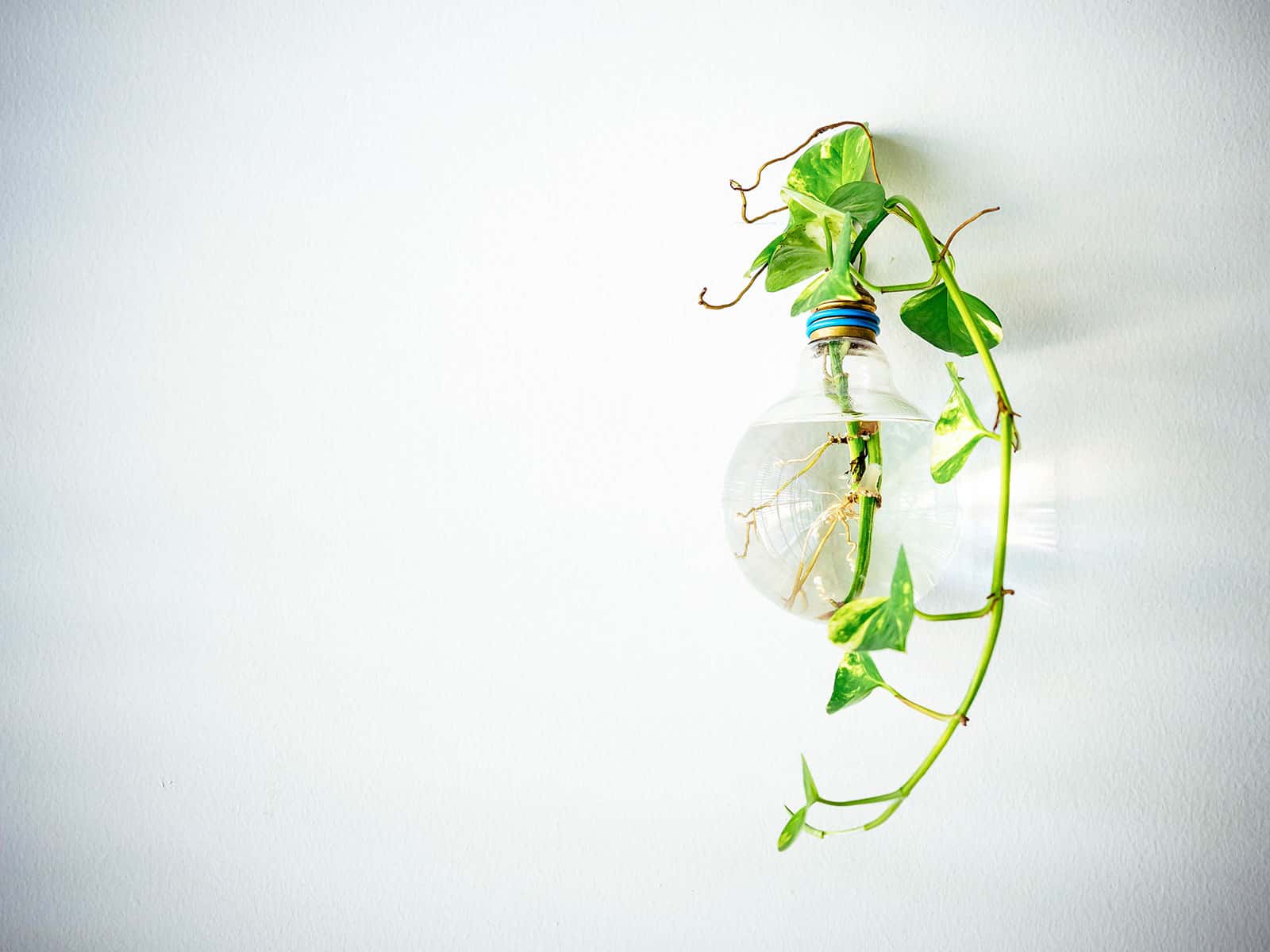
Types of containers to use
So, what kind of container should you use to grow plants in water? Any kind you like!
The only thing you have to keep in mind is the width of the neck if you use a bottle, as your plant will likely grow such an extensive root system that soon you won’t be able to take it out anymore without breaking the container.
I personally prefer doing my hydroponics in clear glass bottles or vases that I find in thrift stores or reuse from around the house. But these days, there’s an array of options for displaying indoor plants in water!
Here are a few popular ideas to consider:
- Glass bottles: Vintage bottles, beer and soda bottles, or fancy liquor bottles can be repurposed as whimsical vases for your indoor plants.
- Glass jars: If you have an odd collection of empty pasta jars or mason jars, turn them into practical containers for your rooted cuttings.
- Drinking glasses: Chipped glasses don’t have to be thrown away—repurpose them for growing! You can also find vintage one-off glasses in pretty colors and patterns at thrift shops.
- Test tubes: A set of test tubes (the same kind used in a lab, or a copycat version designed for home decor) is a great choice for displaying single stems in an eye-catching arrangement. I’ve handpicked the best ones here to show off your plant collection.
- Propagation stations: These tabletop displays (featuring test tubes, bulbs, vases) allow you to arrange all your cuttings as an attractive centerpiece. Here’s a list I’ve curated of beautiful propagation stations for your plants.
- Wall vessels: Wall-mounted test tubes, vases, globes, terrariums, and other vessels can turn your houseplant collection into a work of art. Since plants that grow in water don’t need direct sun, they’re a good choice for almost any wall in your home. Here’s a selection of my favorite wall-hung vases and terrariums.
- Bulbs: Yes, even old lightbulbs work great for small cuttings! With a bit of ingenuity, you can rig up a lightbulb to hang on a wall or suspend from the ceiling.
- Vases: You can use any size vase in any type of material, from clear glass to glazed ceramic (as long as the vase is water-tight so you don’t get leaks). Single stems do best in vases with narrow necks to help keep them upright.
While your choice of water vessel doesn’t necessarily need to be transparent, being able to keep an eye on the root system and reveal part of a plant that you wouldn’t normally see is half the fun for me!
It does mean that any algae growth will be visible as well, but don’t worry. We’ll discuss how to prevent this in a bit.
Did you know?
If you have an aquarium, this is the absolute best place imaginable to grow houseplants hydroponically. Just secure them in such a way that only the roots are submerged (keep the stems and foliage above the water) and you’ll pretty much never have to worry about them. Fish waste contains all the nutrients our plants love, while the roots’ absorption of excess waste helps keep water quality high.
Does any water work?
One of the great things about growing houseplants in water is that yes, any old tap water will almost always work just fine. The only exceptions are if your water is of really low quality, which happens sometimes with well water, or if you use reverse osmosis water, which is devoid of nutrients and minerals and can therefore starve your plant.
If your tap water is high in chlorine/chloramine, don’t worry. You can leave it to sit for 24 hours before putting your plant in it, as these components dissipate over time. Alternatively, you can buy water dechlorinator at any aquarium store.
Rain water and most types of bottled water (avoid brands that are low in minerals) are also absolutely fine.
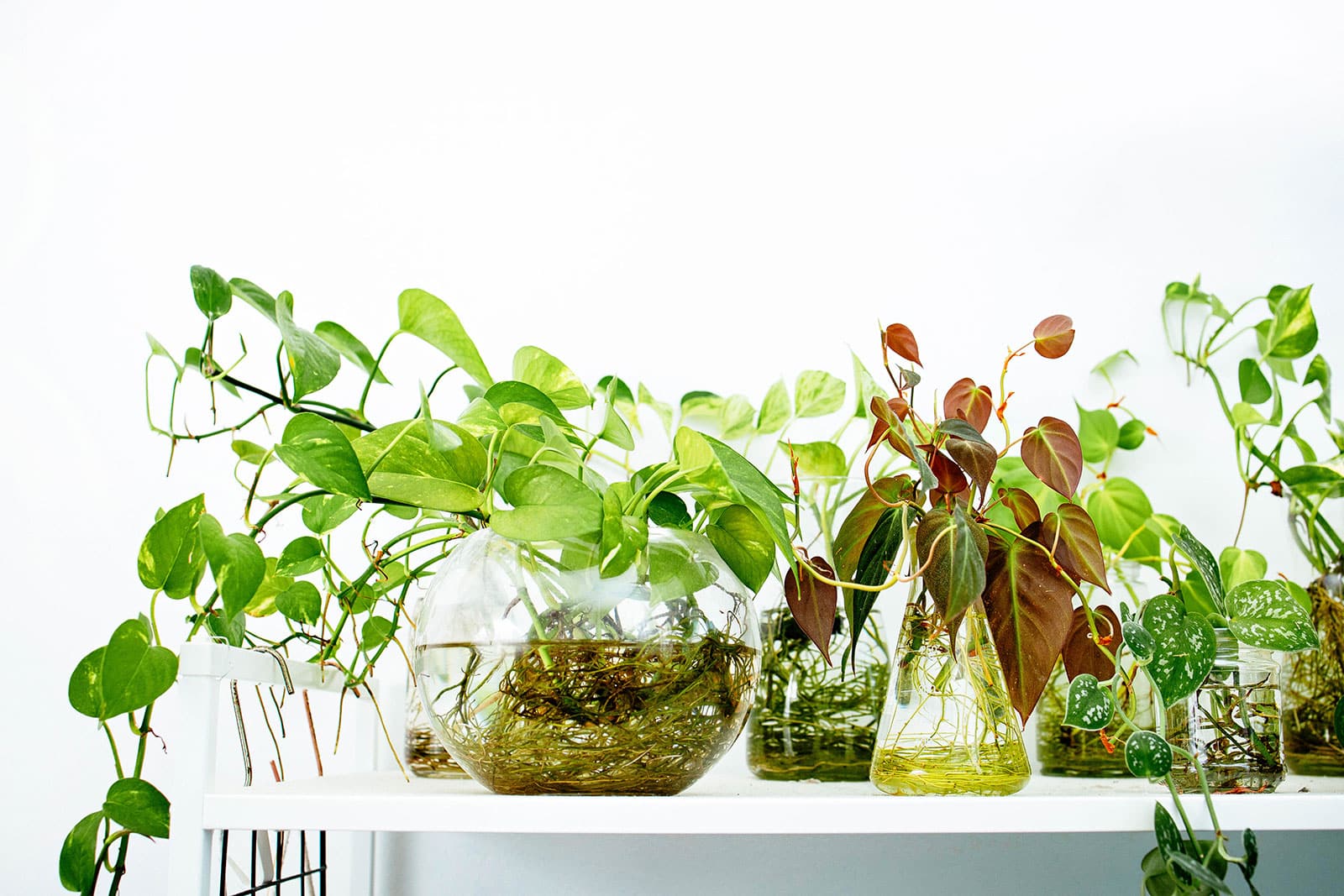
Light requirements
One of the only challenges in growing houseplants hydroponically is finding the right spot in your home for them to live. Putting them on a windowsill that receives direct sun is usually a bit too much, as it can overheat the water.
The excess light is also a recipe for algae growth unless you use an opaque container or a dark-colored glass (like an amber bottle, dark gray bottle, or dark blue jar).
Instead, pick a plant that can take indirect light (again, we’ll discuss a bunch below) and place it in a location that’s bright but not sunny.
Be sure to also avoid drafty parts of the house, because you don’t want the water to get too chilly either.
If algae do occur despite the lower light levels, they’re not too difficult to get rid of. You can either remove the plant from its container for a bit in order to clean it, or you cover the container for one to two weeks to starve the algae of light. The plant itself won’t be affected, since it uses its leaves, not its roots, to photosynthesize.
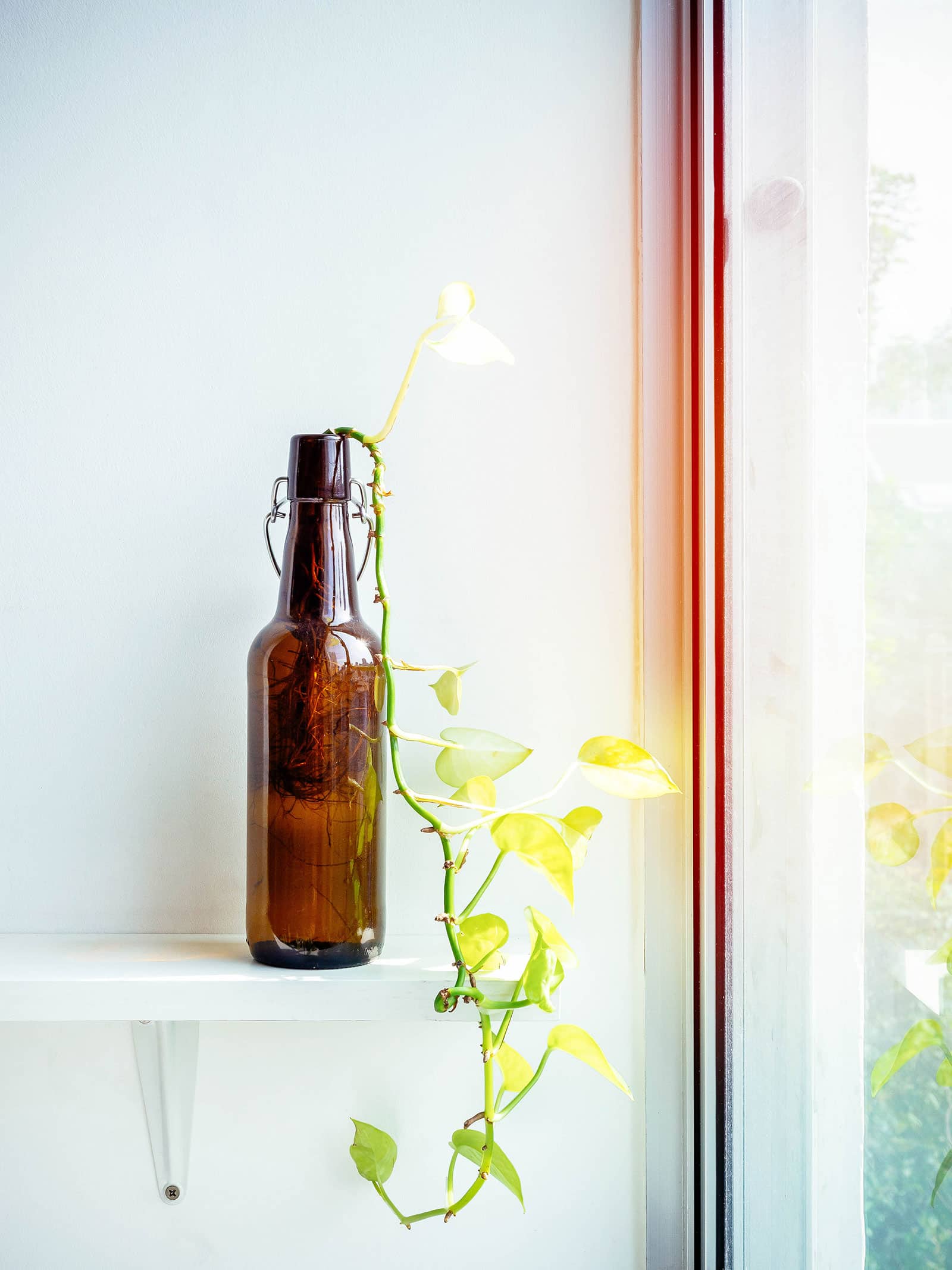
Fertilizing
If you’re wondering at this point how in the world your plant is going to get the nutrients it needs to thrive if it’s growing in water instead of soil, that’s a valid concern. Luckily, it’s easy nowadays to find special fertilizers meant for hydroponic growing. You can use these for well-established (rooted) plants according to the instructions on the container.
Don’t forget to add fertilizer again every time you change your plant’s water, which you should ideally do at least once a month.
Recommended
Fertilizers for hydroponics
Easiest plants to grow in water
1. Peace lily (Spathiphyllum sp.)
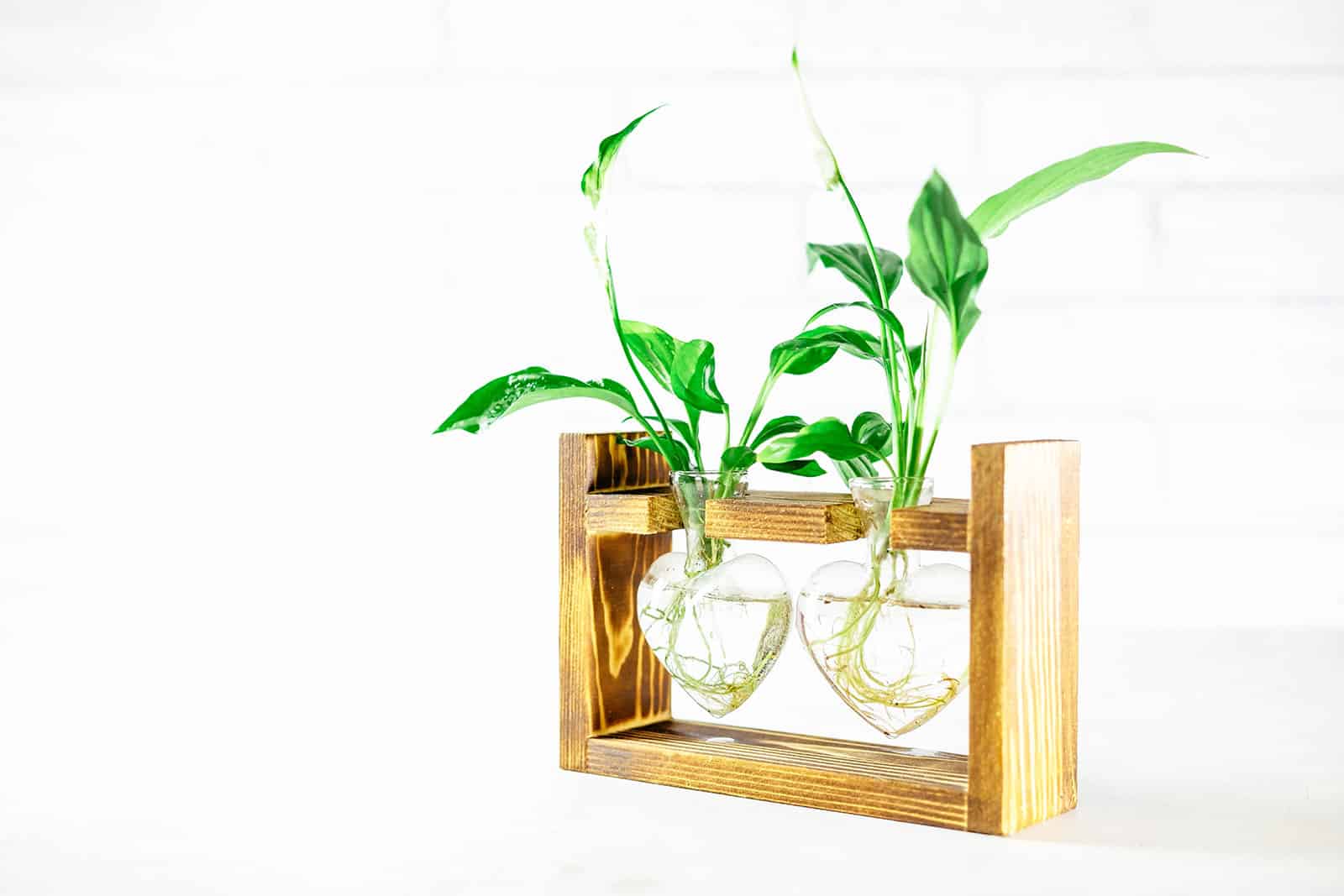
One of the most popular choices for hydroponic growing. This tropical aroid is a classic houseplant due to its easy care and beautiful white flowers, and it will grow very well in water. Provide yours with bright indirect light plus extra nutrients and it’ll bloom almost year-round.
If you’d like to go for something a little more exciting, there are also a few variegated peace lily cultivars available, like ‘Domino’.
2. Lucky bamboo (Dracaena sanderiana)
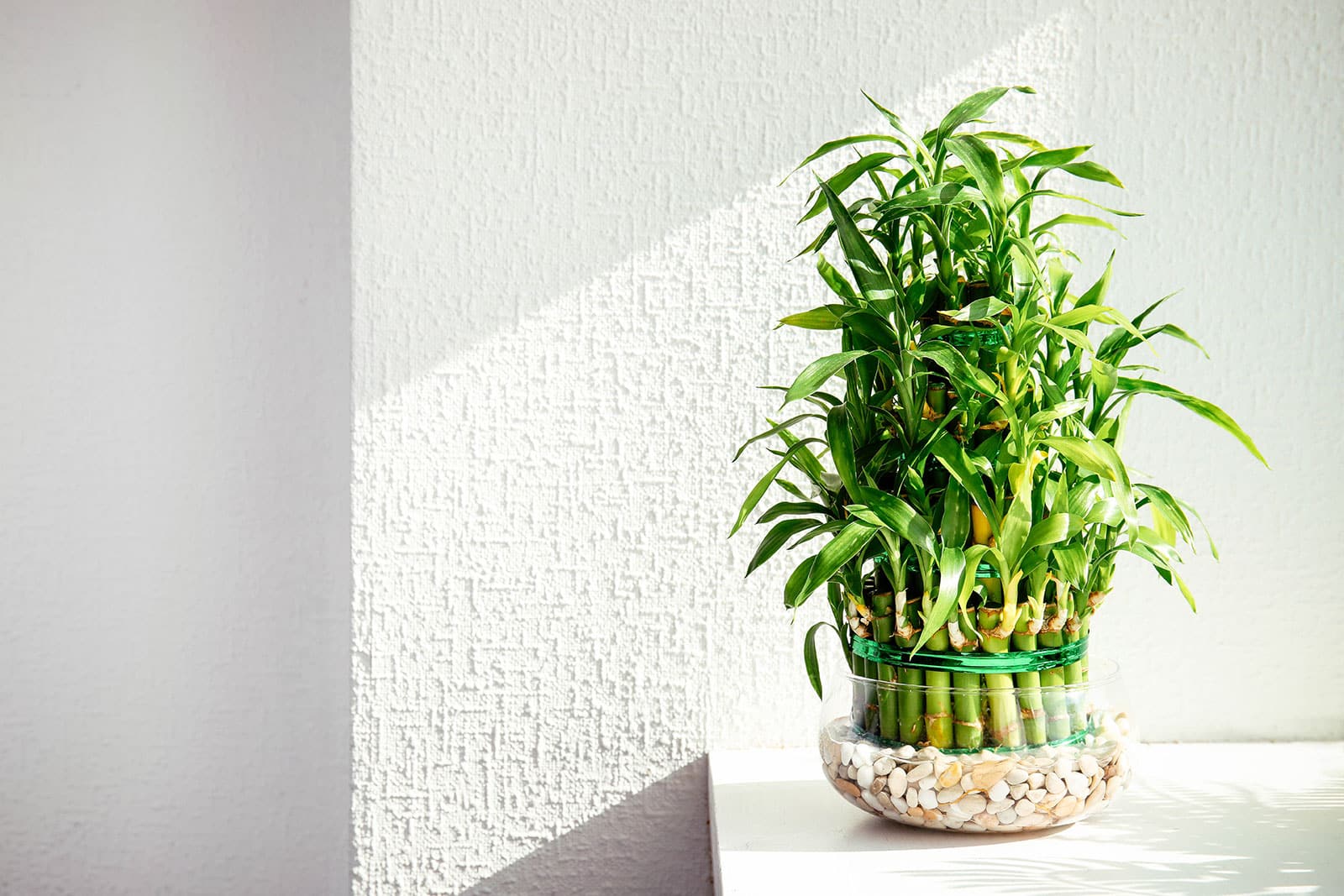
Did you know that lucky bamboo isn’t actually a real bamboo? It’s a member of the extremely popular houseplant genus Dracaena, which also includes the dragon tree and corn plant.
Lucky bamboo is the go-to in terms of plants that grow in water; you actually almost never see them sold growing in soil. I’ve had ones that did well in a simple vase for years even though I never thought to add any fertilizer at all!
3. Pothos (Epipremnum aureum)
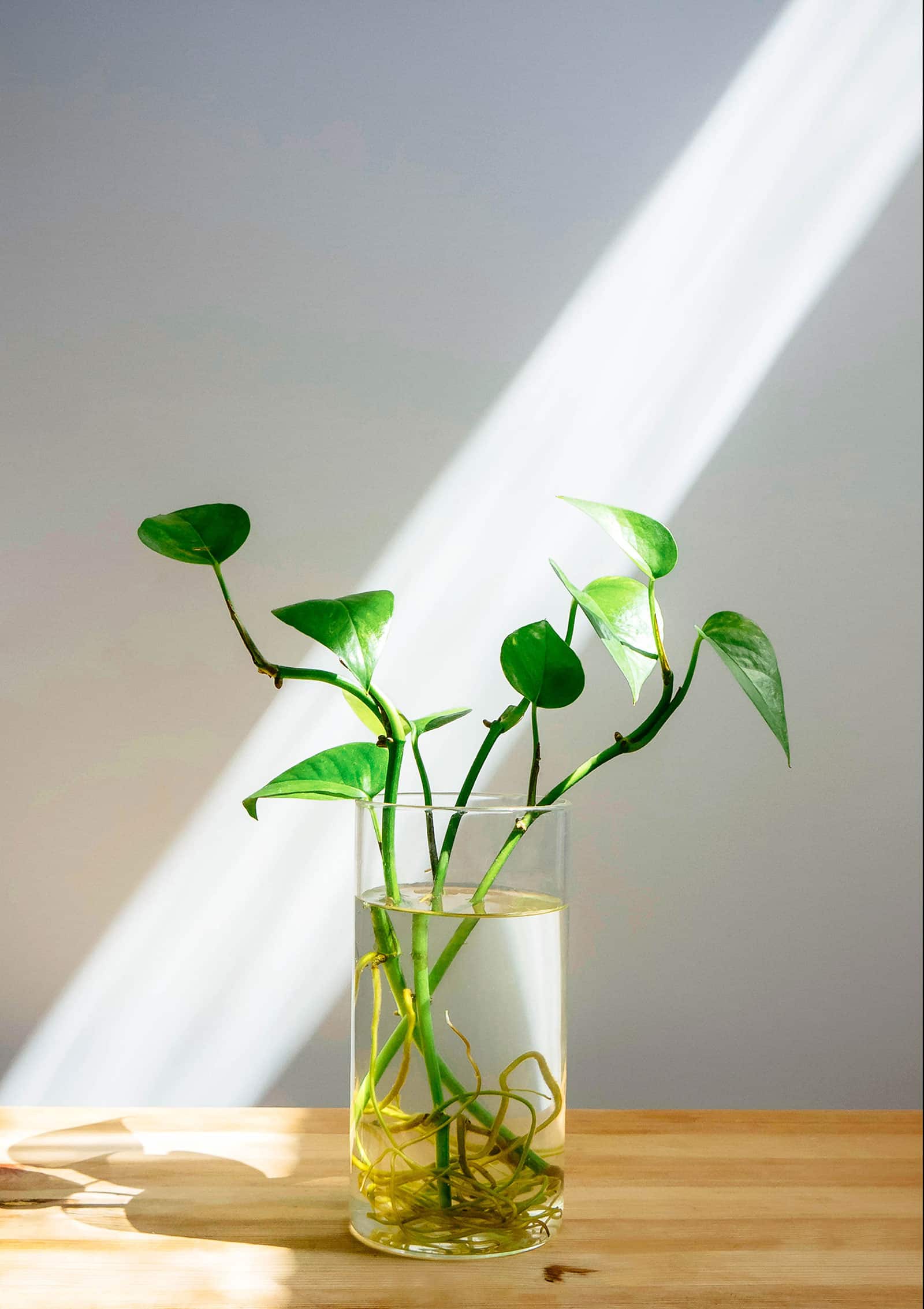
Yep, classic Pothos, everyone’s favorite easy-care houseplant, is a great choice for hydroponic growing. It’s a vining plant, meaning you can snip off a piece anywhere along the stem and place it in a nice vase to root.
This is not the quickest grower, but it handles low-light conditions like a champ. There are loads of different cultivars available: try ‘N’Joy’, ‘Marble Queen’, ‘Manjula’ or just the classic mottled golden Pothos.
4. Flamingo flower (Anthurium andraeanum)
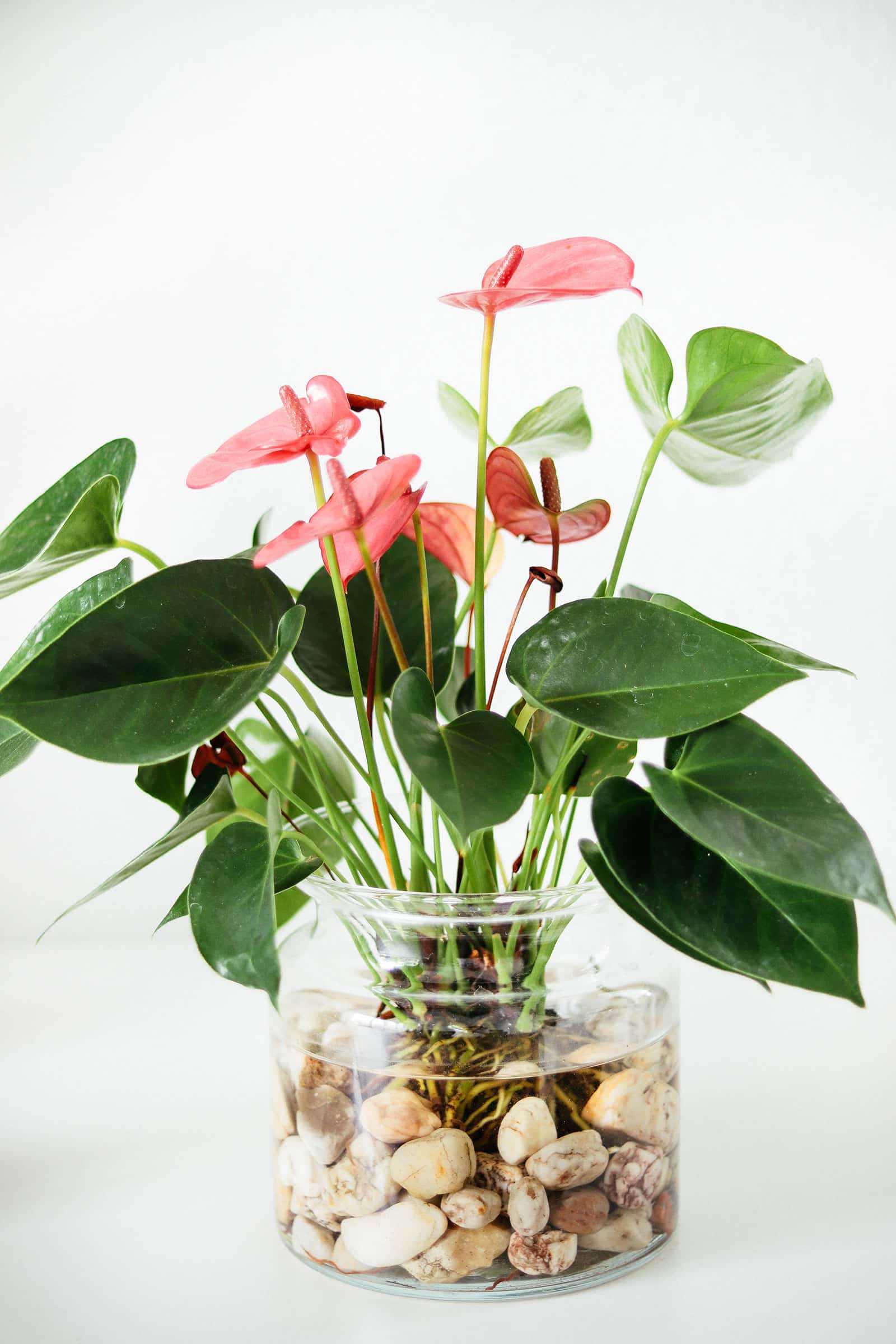
I’ve been seeing more and more houseplant and home interior stores selling flamingo flowers (also known as flamingo lilies) in water, and it’s easy to see why. Also known as Anthurium, this popular aroid produces colorful waxy flowers that create a beautiful contrast with its white roots when kept in a clear vessel.
The classic flamingo lily sports red blooms, but there are also cultivars in pink, cream, green, purple, and even one that’s nearly black.
5. Velvet leaf Philodendron (Philodendron micans)
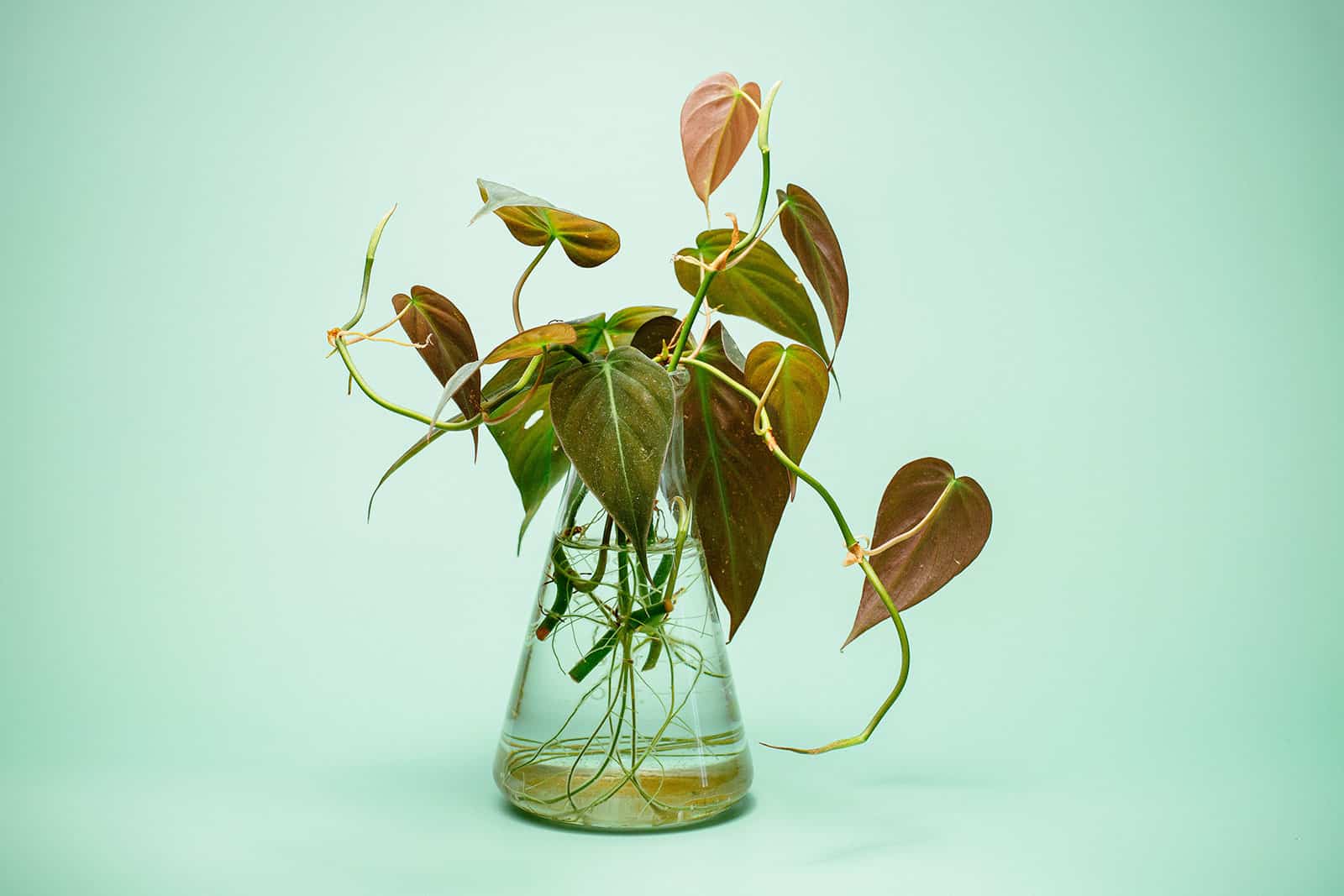
Good ol’ Pothos sound a bit too boring for you? No problem: There are plenty of other beautiful vining species that are equally easy to care for and grow just as well in water. We’ll discuss a few different ones here, including Philodendron micans.
Also known as velvet leaf Philodendron, this species features small, dark green to reddish foliage that’s soft to the touch and almost seems to glisten in the light. It’ll root well and grow vigorously in water.
6. Satin pothos (Scindapsus pictus)
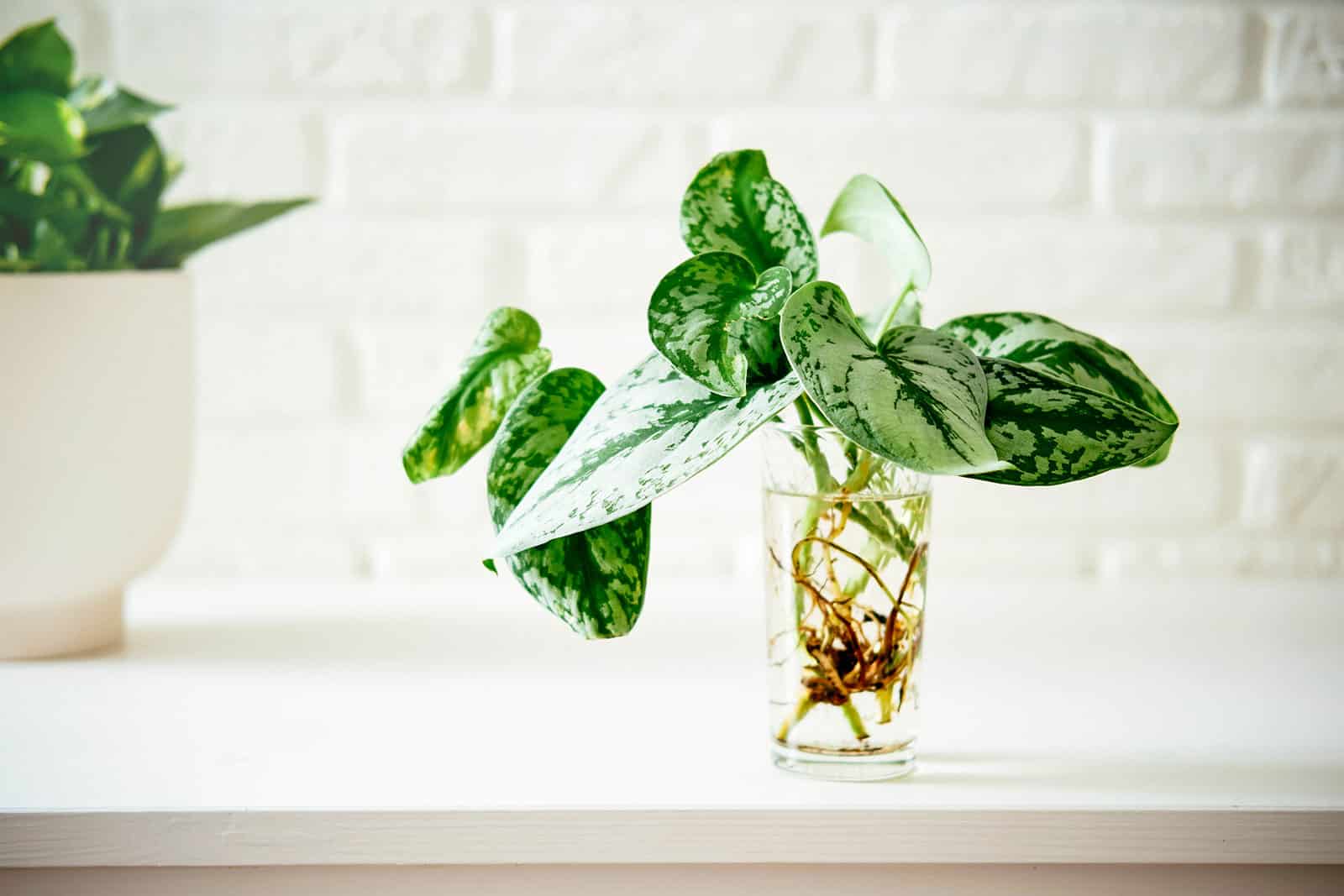
Another vining option known as satin Pothos or silver Philodendron, this one is actually neither: It belongs to a different genus called Scindapsus, despite its confusing common names. The plant’s vining nature and pretty silver leaf spots make it a great choice for a lovely hydroponic display.
As with most of the plants on this list, there are a few different varieties of satin Pothos available. ‘Silvery Ann’ has larger silver splotches on its leaves, while ‘Exotica’ produces XL foliage compared to the other cultivars.
7. Chinese evergreen (Aglaonema sp.)
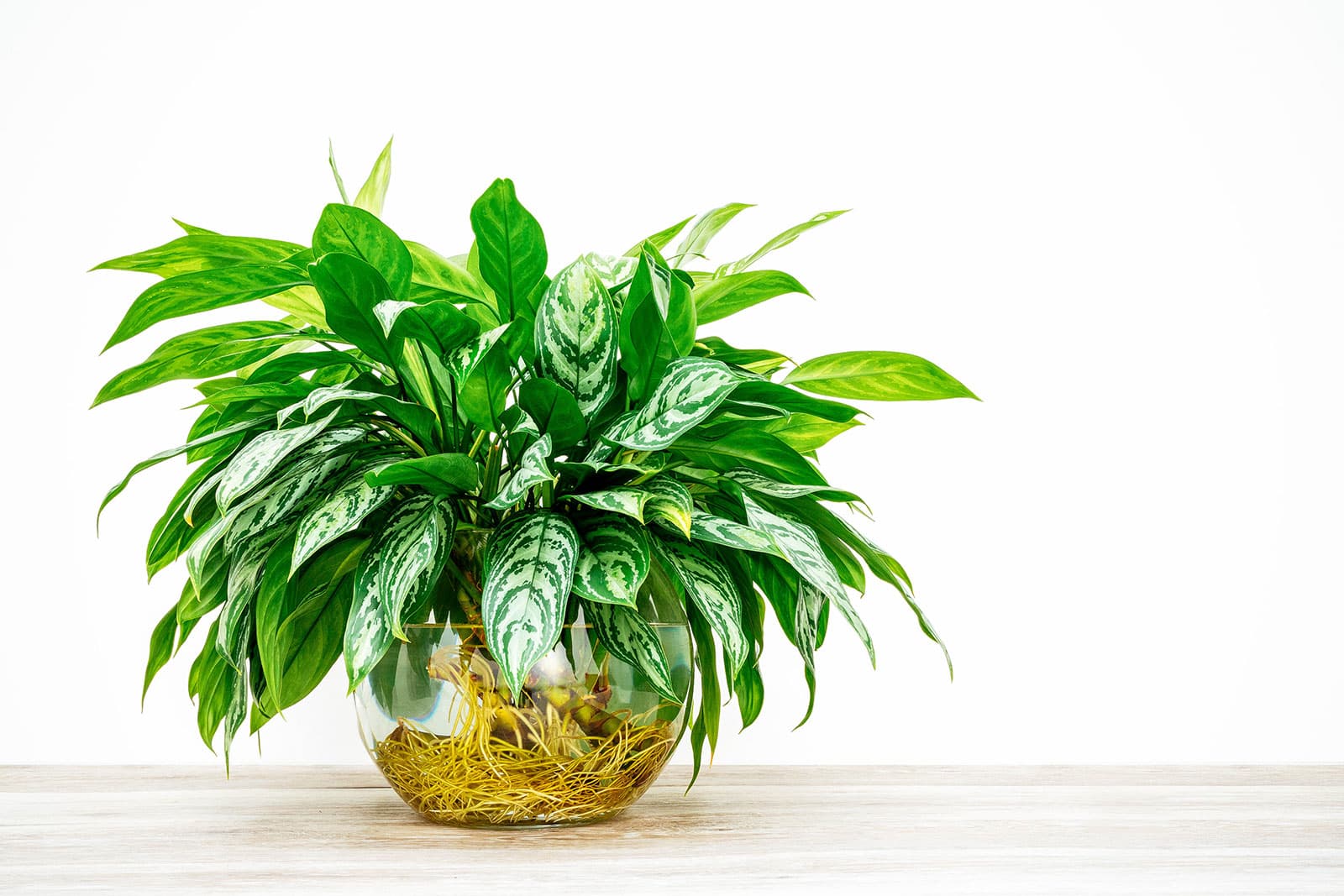
Chinese evergreens from the genus Aglaonema are among my personal favorite houseplants, mainly because there are just so many Aglaonema varieties to choose from. Selective cultivation has produced hundreds of different colors, patterns and leaf shapes, so there’s a Chinese evergreen for anyone!
This is a cane plant (not dissimilar to lucky bamboo), meaning it grows on long stems that should fit perfectly in a thin-necked bottle or vase. It’s hard to choose, but I think my favorite is the pink-rimmed ‘Crete’.
8. Swiss cheese vine (Monstera adansonii)

The classic large-leaved Monstera deliciosa may not be the best choice for growing in water—it just gets much too massive—but its smaller vining cousin, Monstera adansonii, is an excellent choice.
Also known as the Swiss cheese vine, this species has similar fenestrated leaves (leaves with holes), but doesn’t grow quite as unwieldy as its bigger cousin. It roots and grows readily in water.
9. Heartleaf Philodendron (Philodendron hederaceum)
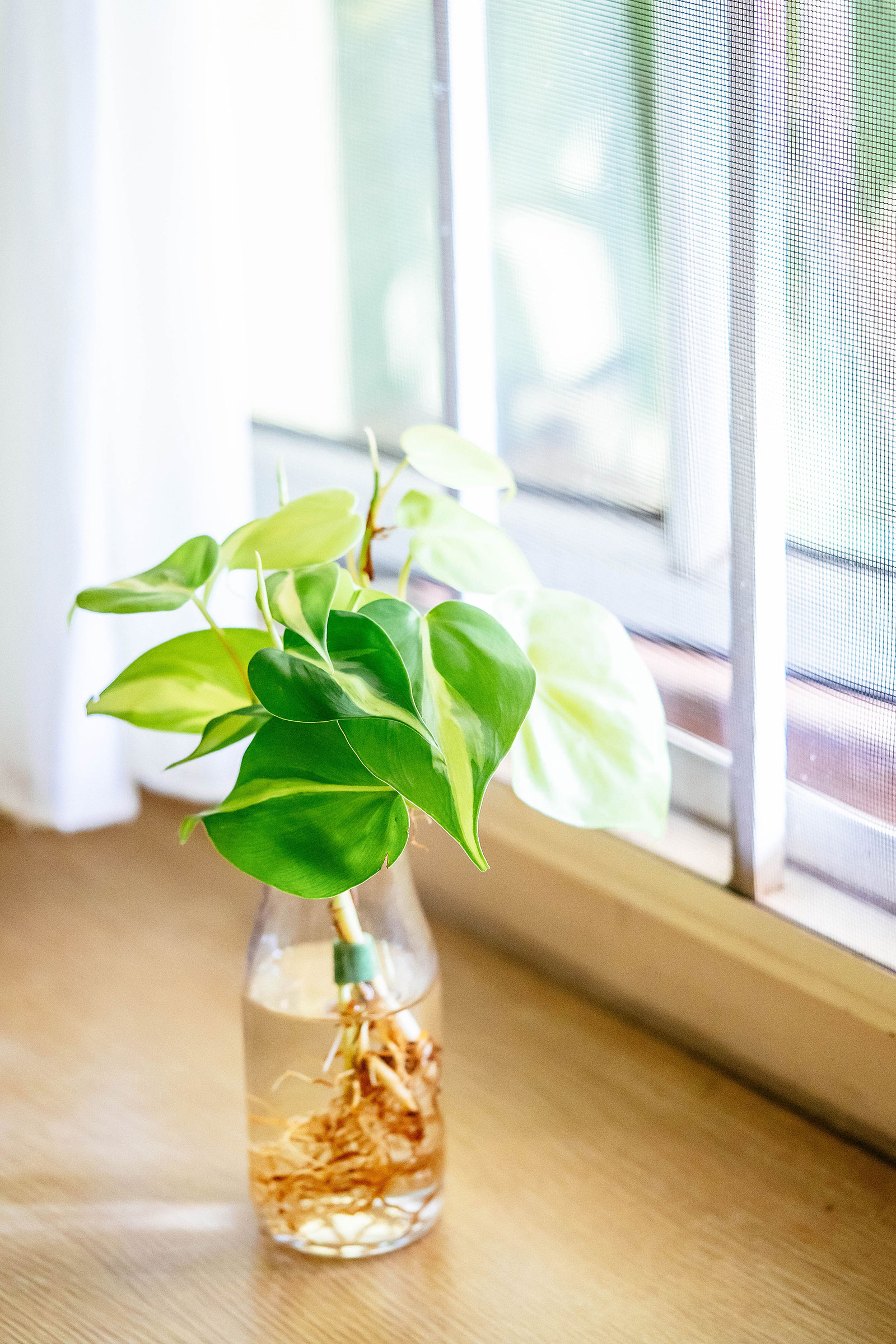
The heartleaf Philodendron is available in a few different colors and patterns, including neon yellow (called ‘Lemon-Lime’) and variegated (called ‘Brasil’).
Another vining species, this one is relatively undemanding and will grow readily in water. I think it would look great in a larger display with other similar plants like the aforementioned Pothos, Scindapsus, and velvet leaf Philodendron!
10. Mini Monstera (Rhaphidophora tetrasperma)
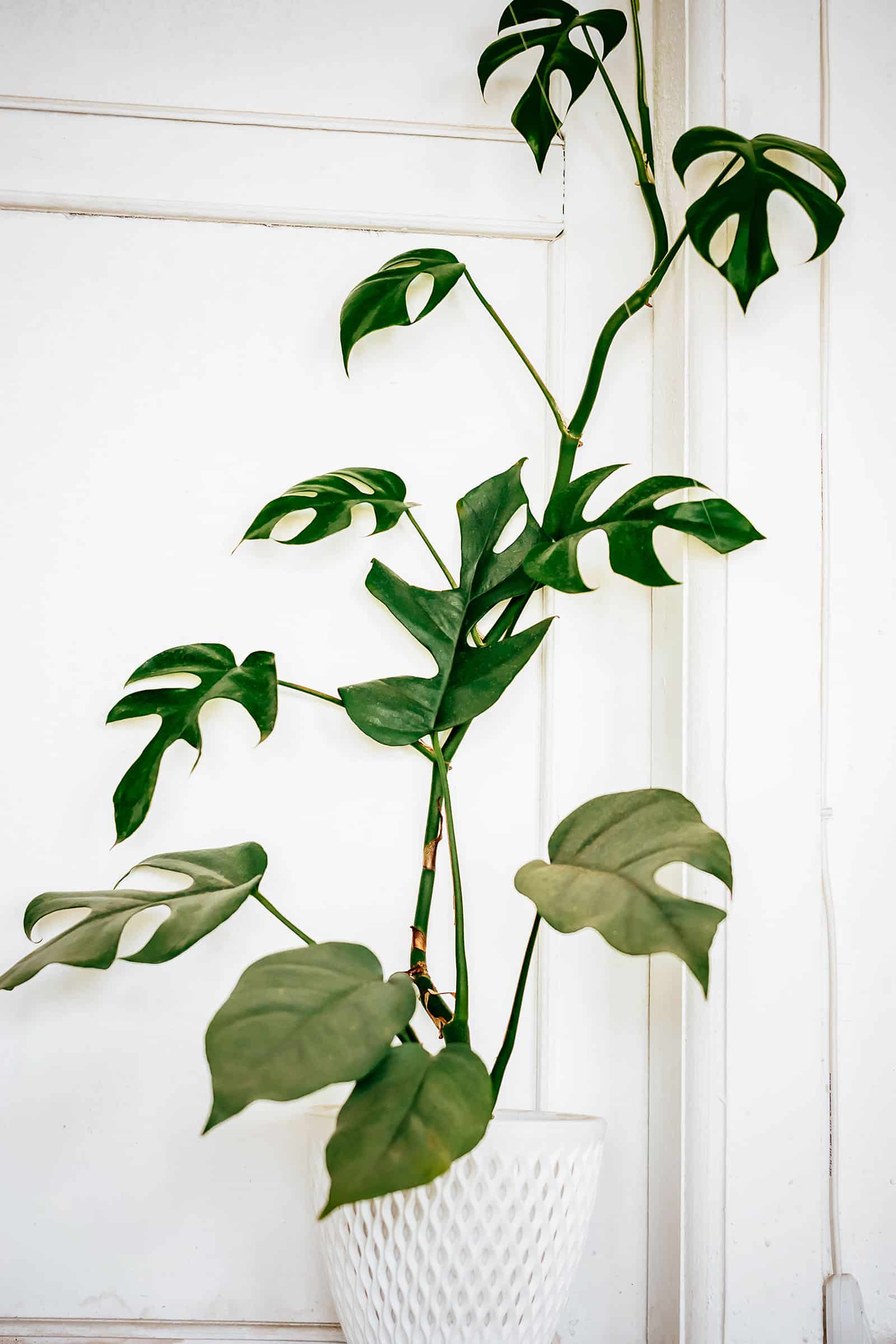
Another great alternative to the large “traditional” Monstera deliciosa is the mini Monstera that’s not actually a Monstera, as it belongs to the genus Rhaphidophora (but is quite similar in terms of looks).
I love combining the mini Monstera with the aforementioned Monstera adansonii. They vine in a similar way, prefer the same light levels, and their unusual leaf shapes go quite well together.
11. Arrowhead plant (Syngonium podophyllum)

The arrowhead plant of the genus Syngonium holds a special place in my heart in terms of hydroponics because it’s the first plant I ever grew in water. I submerged its roots in an aquarium and it grew fantastically for years despite never really getting much light at all.
Definitely one I recommend! Don’t forget to check out the beautiful pink varieties, like ‘Neon’.
12. Inch plant (Tradescantia zebrina)
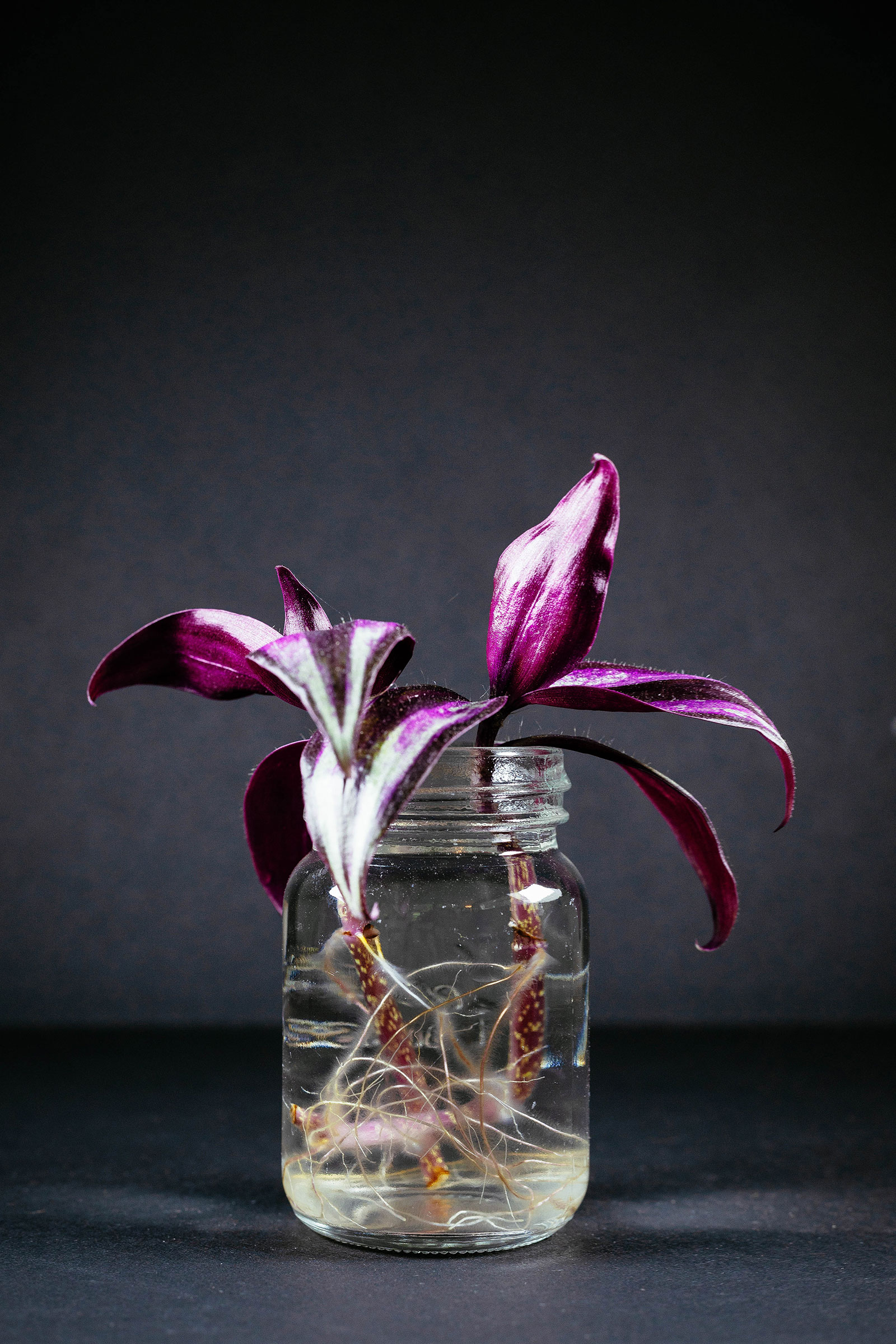
Inch plants (also known as wandering Jew plants) from the genus Tradescantia, like Tradescantia zebrina, are known for being among the most vigorous, fast-growing, and fast-rooting houseplants available.
With how easy these plants are to grow, it’s not surprising they do well in water too. Their pink, purple, and silvery foliage looks stunning in a simple vase! For an extra splash, try looking for the tricolored variegated version.
13. Spider plant (Chlorophytum comosum)
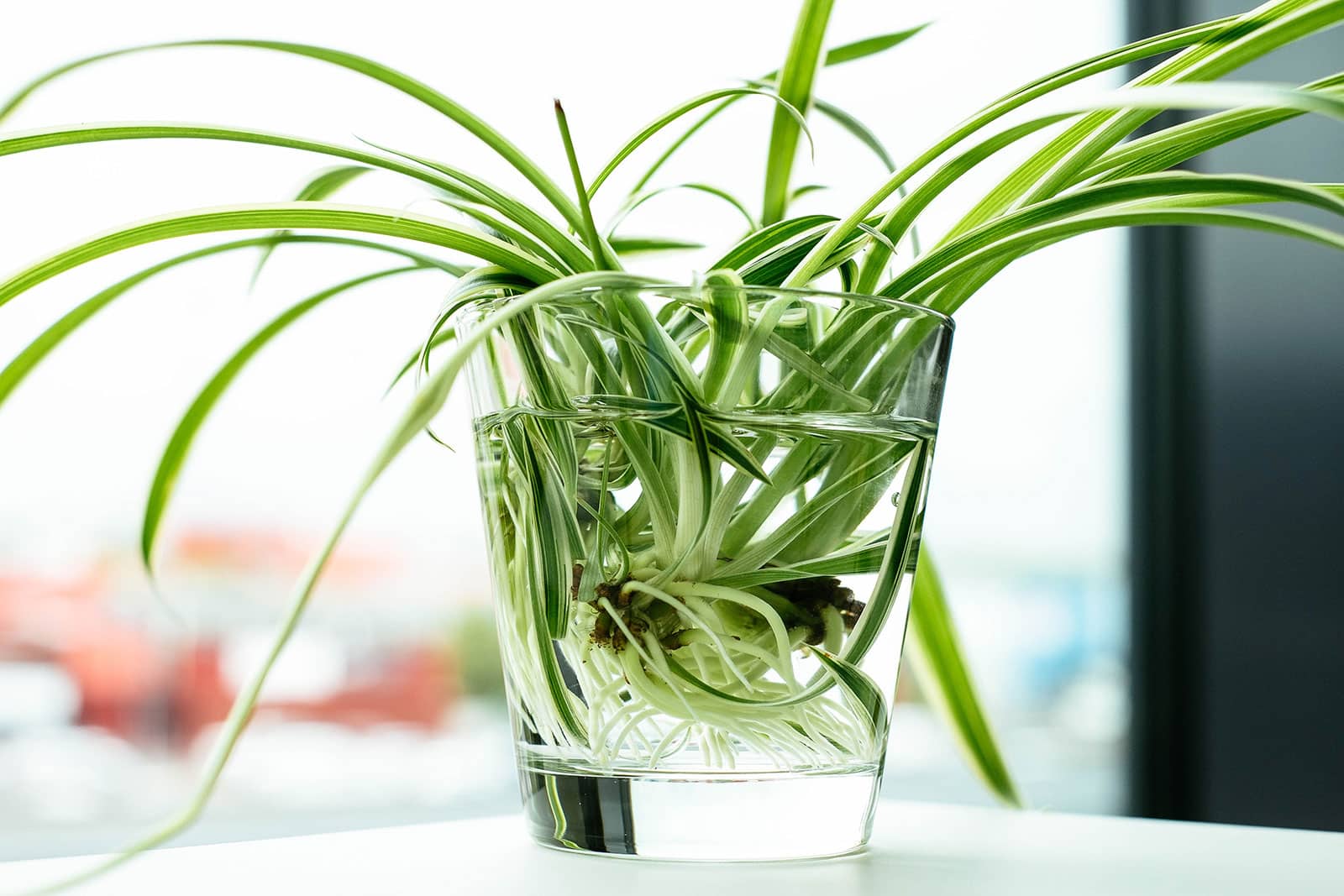
Yet another one of those long-time classic houseplants that no one thinks to put in water for some reason, the spider plant is actually a fantastic candidate for hydroponic growing.
This species is unfussy and doesn’t need a lot of light to thrive. Plus, it produces offsets that are easy to separate. Grow your own hydroponic houseplant army to keep or give away!
14. Prayer plant (Maranta leuconeura)

Prayer plants, like those from the genus Maranta, are considered a little challenging to grow in the home. They can be fussy about watering and humidity.
Although they may not be the first option that comes to mind when thinking about plants that grow in water, growing your prayer plant hydroponically may actually prove helpful in preventing watering mistakes and keeping it alive more easily.
15. Geranium (Pelargonium sp.)
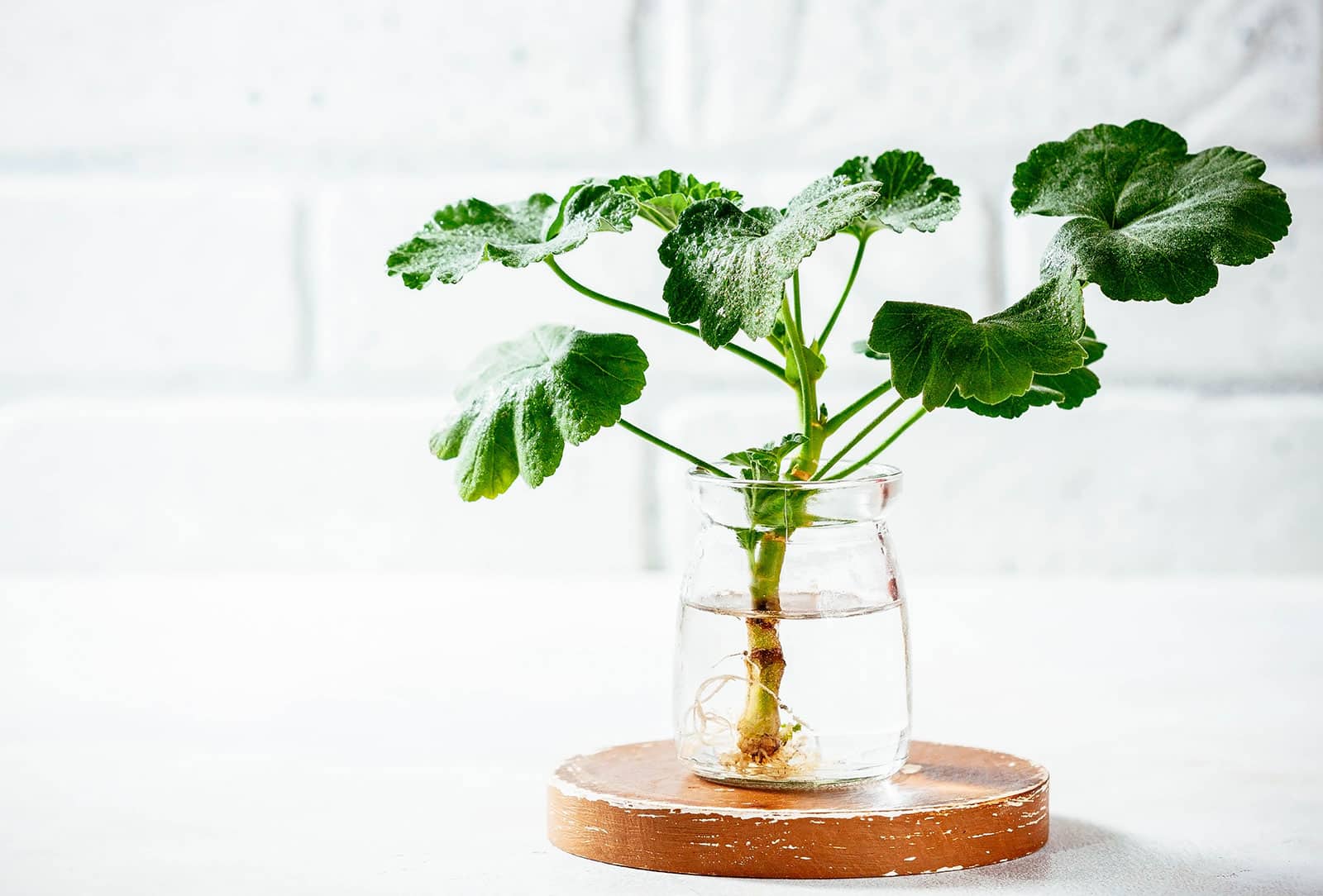
Geraniums are often grown outside as warm-weather annuals, but did you know you can also grow them as long-lived houseplants in water?
If you want to keep your geraniums going through the colder months without the hassle of overwintering their container indoors, clip a 6- to 8-inch piece of stem just below a leaf node.
Place the stem in a glass of water and roots will form. Any cultivar will survive happily in water as long as you remember to change the water every few weeks when it starts to cloud.
16. Begonia (Begonia sp.)
You’ve probably grown Begonias on your deck or patio; these plants are a summertime favorite for adding a splash of color to container gardens. With their waxy leaves and succulent stems, they make a great indoor statement plant as well.
You can grow wax, tuberous, angelwing, or rex Begonias in water. For wax Begonias, clip a stem and place it in water. For tuberous, angelwing, and rex Begonias, a single leaf with the stem attached creates a simple, elegant display.
17. Sweet potato vine (Ipomoea batatas)
Named for its edible cousin, sweet potato vine is an ornamental plant grown for its attractive, heart-shaped leaves and trailing habit. With vines that can reach 4 to 5 feet long, ornamental sweet potato vine looks more like clematis or morning glory. It’s a perfect choice as a lush and tropical-looking “spiller” plant from a wall-hung vase!
The classic plant is lime green, but leaf colors in other cultivars vary in shades of purple, burgundy, bronze, and brown. Take a 6- to 8-inch cutting of the vine, just below a leaf note, to grow in water.


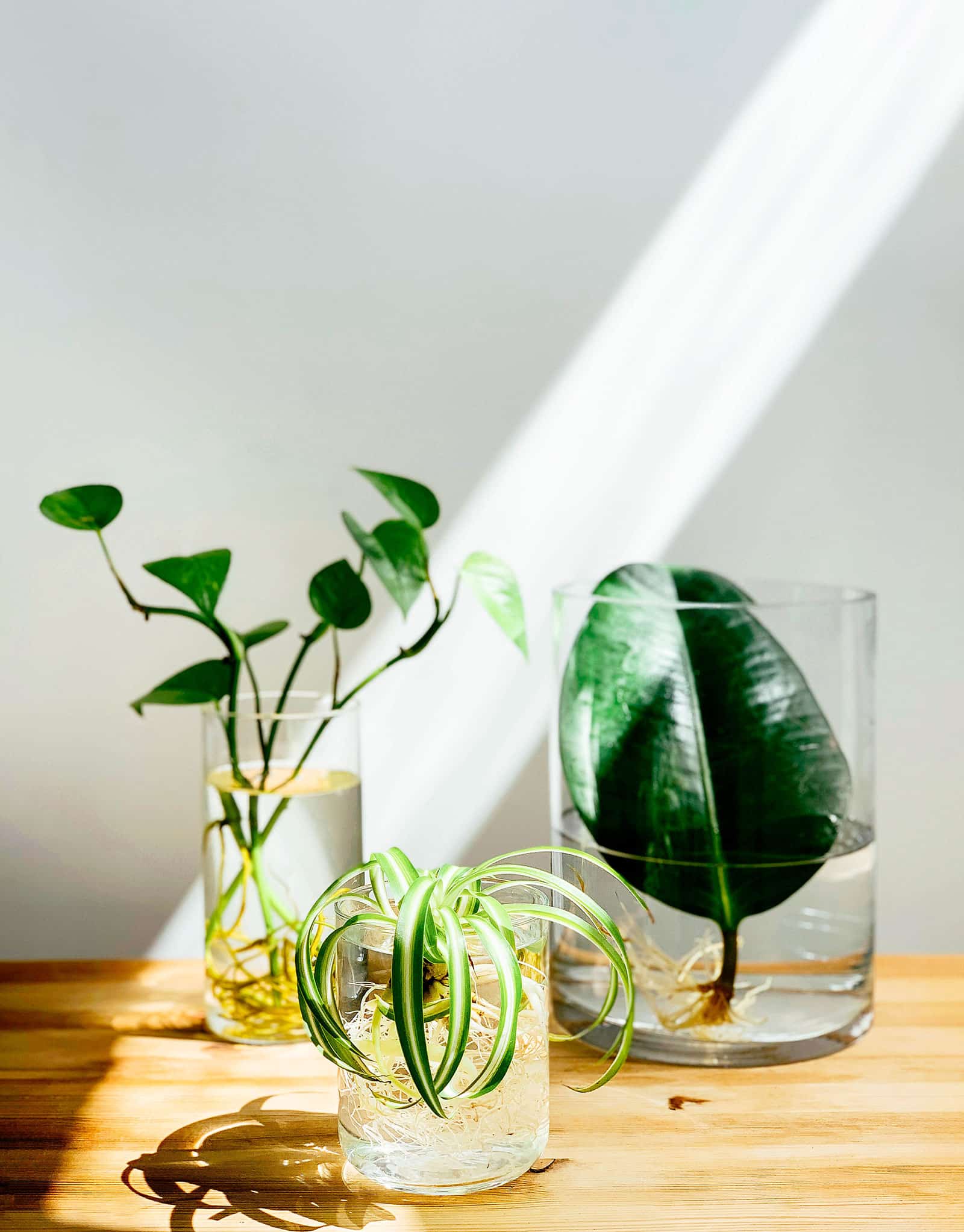













Linda.
Great article about growing house plants in water.
I love it, and will definitely enjoy growing more indoor plants in water.
Thank you very much.
I hope you and your family have a very Merry Christmas and a wonderful New Year.
Thanks again
Tom 🧊
Just wondering about feeding water plants? Anything special to use? Thanks
Great information on plants that grow in water.
Thank you for your light, informative approach to indoor gardening. I am one who forgets to water regularly. Your list of plants to grow without soil has encouraged me to start growing again. Looking forward to reading more of your articles.
You might include with sweet potato vine its cousin water spinach. The cooked greens are delicious, as you likely know. Of course people who live in relatively warm climates, those without dependable killing frosts, need to keep water spinach away from natural bodies of water or places subject to flooding because it can become rampant. Of couse you could then control it with an Asian water buffalo, but what would that huge baby eat after it had cleaned-up the water spinach. Water buffalo are also useful control for water hyacinth, another plant that grows entirely in water and, aside from unlikely blossoms in hydroponically grown sweet potato, would be the only one on an enlarged list with stunning blossoms. Of course they are only suitable to grow in climates that experience frozen ground, as they are a terrible invasive throughout the wet tropics and subtopics. They were established in a pond and canal when we bought a place in north-central Florida and they resisted nights as cold as 11° F. Both water spinach and water hyacinth probably require full sun. Where I now live in central Vermont, they would be an attractive cover in a small ornamental pond, which could be used for frog and toad propagation. Toads in particular, are super controls for slugs, one of the most intractable garden pests here. — Dan Hemenway, Barking Frogs Permaculture.
Hi, thank you for this article. I was given a money tree that had lost 2 of its stems and now only has one left with one leaf, it looked sad but I am determined I can save her so I took her out of dirt cleaned them off ( very little roots on her ) and put her in a vase with rain water that I collect. Will she make a come back this way? Thank you in advance.
You have no idea how happy I am to have found this information on hydroponic growing of certain houseplants! I have an immune deficiency that causes my body to be highly susceptible infection from certain organisms found in soil and aerosolized water. My doctor asked me to remove all my house plants from my living spaces as I also have interstitial lung disease and repeated serious lung infections from those soil & water-born organisms. Being a life-long gardener, I was grieving losing plants that were dear to me. I’m able to wear an industrial half-face mask when gardening outside, but don’t want to have to live with one in the house too. I gave away half my indoor plant children to good friends and family, but have struggled to part with the remaining plants. Now I know I can likely transfer them to water. Watering the plants gently doesn’t aerosolize the water into the air very much, so I should be safe and certainly will be happy to keep my green children around me! Thank you! Thank you!
This was so impressive. I liked it alot and I am looking forward to your articles. Can you please explain about Spider plant (Chlorophytum comosum) more?
Great article! Another plant I have grown in water is the beautiful purple velvet plant. Now I’m off to the thrift store to find some unusual vases, bottles, etc. to show off the plants.
Thanks for the article. To echo a few other people who have replied, the only two on this list that are safe for cats are the spider plant and the prayer plant. Would it be possible to edit your article and include that so the reader doesn’t have to look up every single plant to see if it’s safe? That would really add a great component to this article!
Hi there,
I have just been given a flamingo flower plant in water last week. Can you please advise as to when do I need to change the water or add more water? I understand about keeping tap water for over 24 hours before using it to water indoor plant.. thanks
Hi, I have lucky bamboo in a vase in my bathroom. I’d like to add another plant that thrives in water with the bamboo, low growing.
Any suggestions?
Thanks, Amy
Also, there are lots of rocks because of the bamboo…
Hello! new to being a plant parent.
Any suggestions for plans that grow in water that does not need sunlight?
I think closests you will get is golden phothos (my experience) but any pothos/phelodendron would work..
I had my golen photos living in a dark BED room with occasionally daily use lights but this will be very slow growth and smaller leaves.
They do well in any room where you will use your light often. Bathroom, living room etc, even if there is no to barely any sunlight. My office Glde Pothos grows very will with just office lights (tube/flourescent lights), which i assum e its on 16 hrs a day.
good job
Is it ok to have rocks/pebbles in the bottom of the vases of water? Or is there any risk with that? I have some wall-mounted vases that I’m doing hydroponic growing of spider plants, tradescantia zebrina, pothos, and philodendron – in case that affects the answer. Thank you!
You can have (clean) rocks in the bottom of the vase if they’re just meant for decoration or to help hold the stems up.
Look for leca balls. They’re the appropriate type of “rock” for this type of medium. They’re actually clay balls.
Granite crushed to small pieces will supply small amounts if of potassium and even smaller amounts of trace minerals. Limestone, or better, dolomite, pieces will supply calcium and, in the case of dolomite, magnesium. Because limestone and dolomite raise water pH, it would be best to mix small amounts with more inert rocks. (Granite also raises pH but dissolves barely, so I doubt the effect would be significant.) Sea shell contains calcium as well as trace minerals from the ocean and could provide visual interests, our could be crushed such as is done for chicken grit. Granite is crushed for pigeon grit. So these would be availabe from any good feed store and maybe from Tractor Supply. Toss in a goldfish or two, as Linda suggests, and you have a little ecosystem. The shells provide a substrate for bacteria that cleanse the water from ammonia and other fish ‘wastes.’ They are only wastes if you waste them. If you have an attached greenhouse or south-facing porch, you can raise fish to eat and cycle the water to tilapia that you will eventually eat. If you can find copies of the old journals from the (now defunct) New Alchemy Institute, they should have details. An alternative to goldfish, BTW, are mosquito fish, which are good to use in rain barrels in the summer (to control mosquitoes, of course), and can be overwintered in goldfish bowels inside. You would need to investigate what they could eat in winter. They are smaller than goldfish, reproduce as plentifully as guppies, their relatives, and might well thrive on whatever is feed to guppies. If you like to fish, they could serve as bait for something the size of perch, but DO NOT DO THIS IN WATERS THAT DO NOT ALREADY CONTAIN THEM. They are a nuisance in New Zealand, where they have been informally introduced, because they eat the eggs of trout, deliberately introduced to foster tourism. I can provide more on mosquito fish, but I’m getting more than a little far afield for this venue.
Amazing article! Super helpful and very thorough. Perhaps I missed it, just curious if you have to change the water every so often for good plant hygiene ?
I’m thinking of trying this with my rubber plant, being sure to keep the stall out of the water. But maybe that isn’t the best plant??
Let me know what you think (:
Yes I do recommend changing the water whenever it starts to look murky. Ficus elastica (rubber plant) can be kept alive in water for several months, but it won’t branch out and turn into a full plant like the others listed here.
I just bought one and I’ve been googling bc I love having plants in water but unfortunately everything I’ve read says they don’t like being left in water 🙁
Hey Linda,
Just one thing … almost all these plants are very toxic to dogs and cats. I think it is important to mention that!
Hello,
NICE.
Thanks
Hi silly question but I really like the plant in one of your photos. It’s the first one in this article with 3 plants in it and it’s the one on the extreme right, the one with a single large leaf. May I know what is that plant pls? Thank you so so much and thank you for this article. It’s so helpful!
The far right cutting is a leaf from a rubber tree (Ficus elastica). You can root the leaf in water and keep it alive this way for many months, but it won’t ever branch out and turn into a full plant.
Thank you so much for replying and so quickly as well!! (:
I took my rubber plant out of soil, cleaned the roots, and put in water. Would it be the same for an established plant? Only a few months in water? I’ve had 2 new leaves since putting it in the water last week. Thanks for any info!
Hi Linda ly where I can buy those plants like lucky bamboo,photos&Chinese evergreen?
Lucky bamboo: https://rstyle.me/+c0dU2nFH7US-0uritNrQ2A
Pothos and Chinese evergreen: https://rstyle.me/+qjRj3uZsAIJy1_Jpn1S30g
Thank you so much Linda Ly for this article and for many others I’ve read since finding you!! I intend to try a couple of your recommended plants in water to see how I feel about that. I have as large an “indoor” garden as I have space for mainly because I love plants and also like their clean air qualities. Will plants in water offer those same qualities as plants in soil? Again thanks for such in-depth informative articles!
Yes, it’s always beneficial to have plants in your house, whether they’re grown in soil or in water. I hope you found some that you like from this article!
Tysm for this nice information
Thank You, I really appreciate this list. I have many of these plants and am constantly trying to work out an appropriate watering schedule.
Hi LindaLy,
Thank you for this list of plants I can grow in water!
I appreciate you and your articles you so willingly share.
Sincerely,
Belinda
Any recommendations for plants that grow in water that are not toxic to pets?
Can I buy house plants from you?
Just click on the links she provides in her articles to buy from sources she uses!